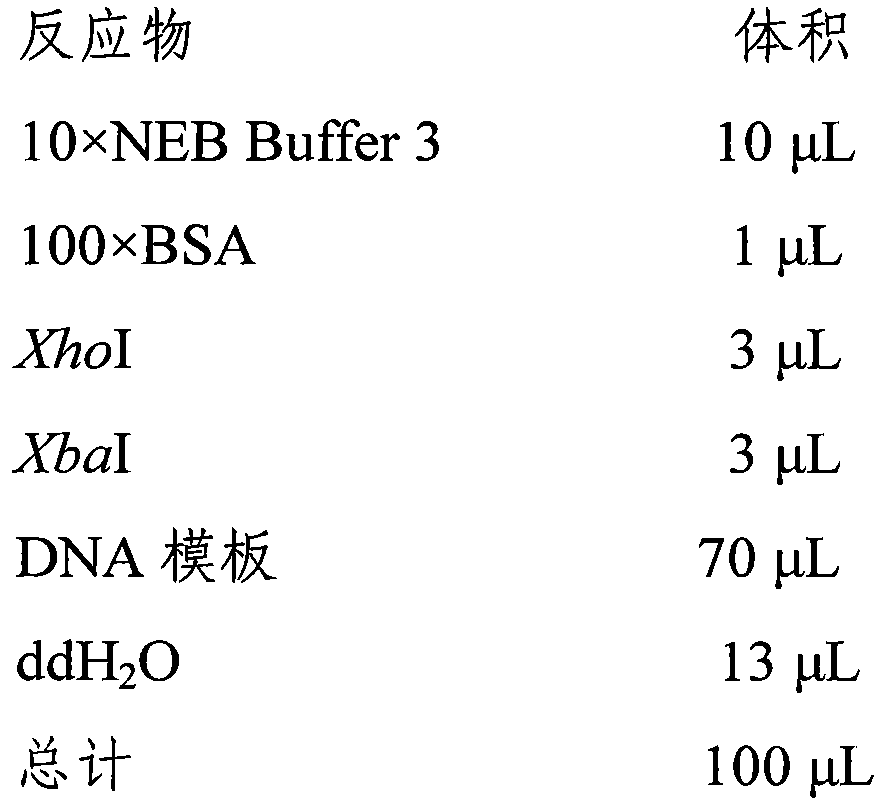Group of trypsin resistant antimicrobial peptides and preparation method thereof
An antimicrobial peptide and a series of technologies, applied in the fields of protein engineering and genetic engineering, can solve problems such as restricting the effect of oral treatment, affecting the stability of NZ2114 trypsin, and losing activity
- Summary
- Abstract
- Description
- Claims
- Application Information
AI Technical Summary
Problems solved by technology
Method used
Image
Examples
Embodiment 1
[0034] Example 1 Molecular design and gene synthesis of trypsin-resistant antimicrobial peptides
[0035] According to the presence of 6 trypsin cleavage sites (R14, K20, K23, K26, K32, K38) in the NZ2114 sequence, it binds to its active site and key structural sites. A total of 33 sequences (SEQ ID No. 1-SEQ ID No. 33) were designed for single-site mutants, double-site mutants and triple-site mutants.
[0036] The mutant gene sequences (SEQ ID No. 34-SEQ ID No. 66) were designed according to the codon preference of Pichia pastoris. In order to ensure the integrity of the sequence during expression, an XhoI restriction site and a Kex2 restriction site were added to the 5' end of the mutant gene sequence, and a TAA, TAG terminator sequence and XbaI restriction site were added to the 3' end. The above sequence was completed by Shanghai Sangon Bioengineering Co., Ltd.
Embodiment 2
[0037] Example 2 Construction of Pichia pastoris constitutive expression vector pGAPNZTYR1-pGAPNZTYR33
[0038] The synthetic gene fragment and the vector pGAPZaA were double-digested with restriction endonucleases XhoI and XbaI respectively, the pGAPZaA vector fragment and the mutant gene fragment were recovered, ligated, and the vectors pGAPNZTYR 1-pGAPNZTYR33 were obtained;
[0039] The detailed construction process of the vector pGAPNZTYR1~pGAPNZTYR33: use restriction endonucleases XhoI and XbaI to carry out double enzyme digestion on the synthesized gene fragment and pGAPZaA respectively, the enzyme digestion system and conditions are as follows:
[0040]
[0041] After adding the sample to the above enzyme digestion system, react at 37°C for 3 hours, and detect by 2% agarose gel electrophoresis, electrophoresis conditions: 120V, 30min. After electrophoresis, use a scalpel to cut the electrophoretic bands corresponding to the carrier fragment and the gene fragment unde...
Embodiment 3
[0058] Example 3 Construction of recombinant yeast strains containing pGAPNZTYR1~pGAPNZTYR33
[0059] 3.1 Linearization of recombinant vector pGAPNZTYR1~pGAPNZTYR33
[0060] Use AvrII to digest the constitutive recombinant expression vector pGAPNZTYR1~pGAPNZTYR33. The enzyme digestion system and reaction conditions are as follows:
[0061]
[0062] After adding the sample to the above enzyme digestion system, react at 37°C for 3 hours, and detect by 2% agarose gel electrophoresis, electrophoresis conditions: 120V, 30min. After the electrophoresis is completed, it is detected that the recombinant expression vector is correctly linearized, and then the linearized recombinant expression vector is recovered using a DNA recovery kit.
[0063] 3.2 Pichia pastoris electrotransformation and identification of linearized vector
[0064] 1) Pick a single colony of X-33 on the YPD plate, inoculate it into 10mL YPD liquid medium, culture at 30°C, 250rpm overnight;
[0065] 2) Inocula...
PUM
 Login to View More
Login to View More Abstract
Description
Claims
Application Information
 Login to View More
Login to View More - R&D
- Intellectual Property
- Life Sciences
- Materials
- Tech Scout
- Unparalleled Data Quality
- Higher Quality Content
- 60% Fewer Hallucinations
Browse by: Latest US Patents, China's latest patents, Technical Efficacy Thesaurus, Application Domain, Technology Topic, Popular Technical Reports.
© 2025 PatSnap. All rights reserved.Legal|Privacy policy|Modern Slavery Act Transparency Statement|Sitemap|About US| Contact US: help@patsnap.com



